Our 2019 Porsche Cayenne Earned Our Respect
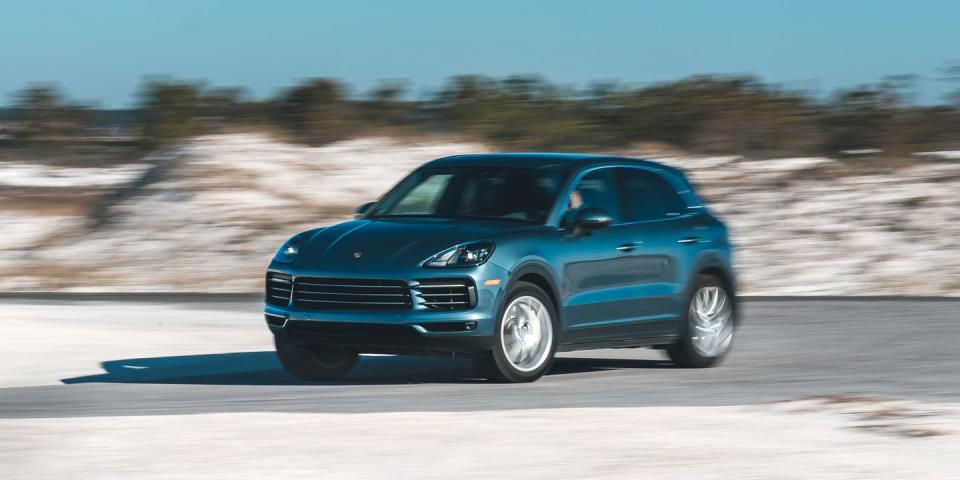
From the November 2021 issue of Car and Driver.
40,000-Mile Wrap-Up
Twenty years ago, this long-term review would likely be covering a Mercedes-Benz E-class or an Audi A6. Back then, that was how middle managers rewarded themselves. Porsche changed that with the introduction of the original Cayenne for 2003. Luxury-grade sport-utility vehicles, like our 2019 Porsche Cayenne, are what fill the country-club parking lot, because they can do all the three-box cars' tasks and more. Tow up to 7716 pounds on Sunday, take three kids to school on Monday, transport sporting goods for a week's worth of activities, and still catch the attention of valets on Friday night. The Cayenne fulfills all needs.
Ordering a Porsche can be fun, especially if you're not using your own money. Most entry-level, 335-hp Cayennes go for about $80,000, so we set that as our price target. But starting at $66,950 meant we had to show restraint. In the interest of testing it over 40,000 miles of abuse, we added the newly available $3490 Porsche Surface Coated Brake system, which promises to reduce brake dust. The tungsten-carbide-coated rotors are larger and necessitate stepping up to a 20-inch wheel, bringing the brake option to $5210. Add Biscay Blue Metallic paint ($800), 14-way seats ($1900), heated front seats ($530), a trailer hitch ($660, which also requires a $75 wiring harness later picked up at the dealer), adaptive dampers ($2000), and the Sport Chrono package ($1130), and you have a $79,530 Cayenne that's ready for action.
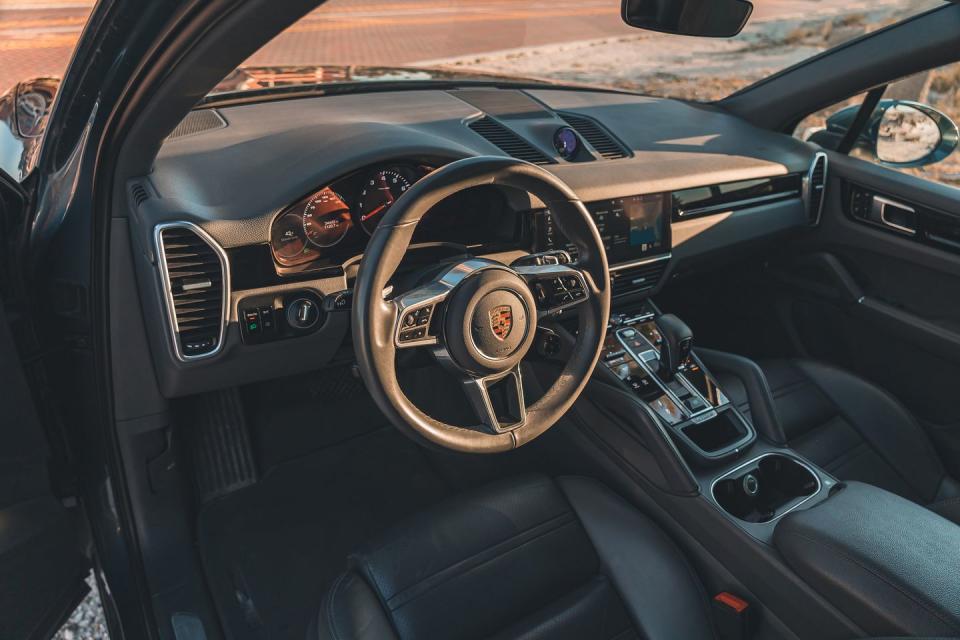
If you've used your calculator watch to figure out that $350 is missing from our tally, we spent that on Porsche Experience Center delivery in Atlanta. It's like European delivery, except you're in Atlanta. For that money, you get an on-site tour of Porsche's Experience Center, an in-depth orientation on your new car, and, most important, some on-track driver training and a nice lunch. Porsche offers the delivery at its Experience Center in Los Angeles too. If you're new to the Porsche family, it's a nice way to meet your car, particularly if you spec'd the vehicle yourself. Fly in, get some track time, then drive home.
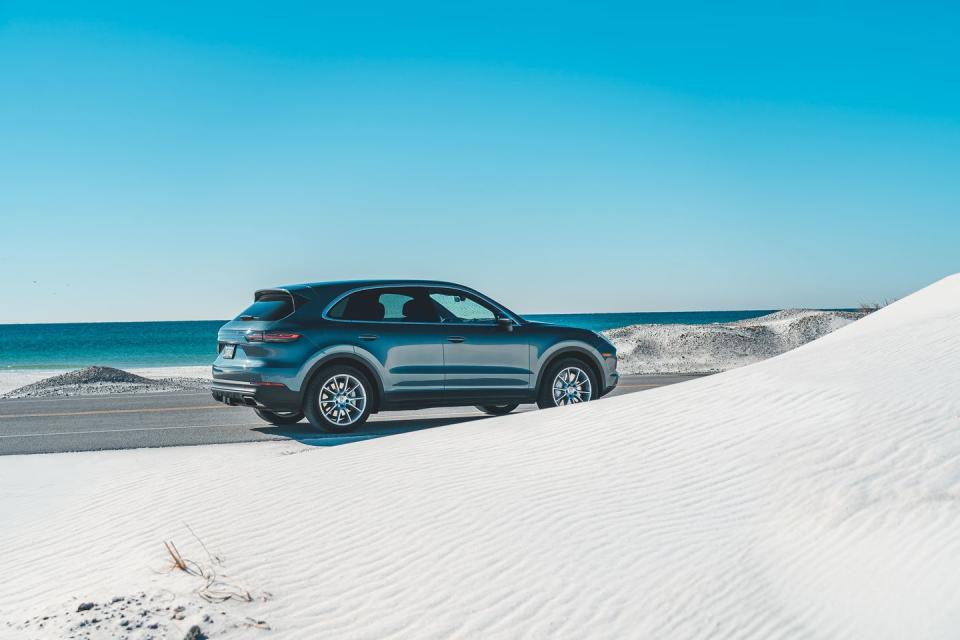
Although it wasn't cold in Atlanta, the expedition back north happened in November, so we outfitted the Cayenne with Porsche-spec Michelin Pilot Alpin 5 winter tires ($1506, before installation) while still in Georgia. They would serve us well through two seasons. Had we kept the Cayenne for another winter, we'd be replacing the rears, likely an indication of how often our editors attempted to re-create the Cayenne's 4.9-second sprint to 60 and 13.5-second quarter-mile. On the wide Bridgestone Dueler H/P Sport summer rubber, the Porsche stopped in 158 feet from 70 mph and held the skidpad to the tune of 0.95 g.
As soon as the Cayenne arrived, it became the choice for weekend trips, traversing Michigan's Upper Peninsula for a New Year's holiday in northern Wisconsin. The logbook filled with notes complimenting the driving dynamics and build quality. The brake pedal drew complaints for its sensitivity, particularly at low speeds. But at least some staffers admitted that they got used to the touchiness after a few days behind the wheel. We regretted not selecting keyless entry for $940, because keyless start is standard. It's a mistake we won't make again, since Porsche made keyless entry and start standard for 2020.
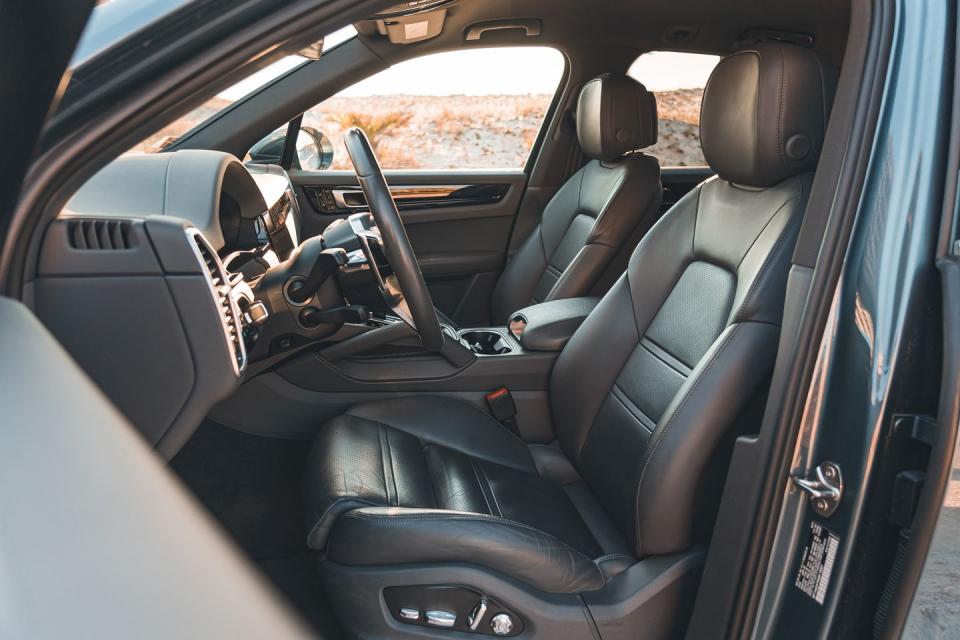
Two recalls befell the Cayenne. The fancy brakes got their front pads replaced with an updated compound, and the rear-brake-pad springs were swapped out. The dealer informed us of the recalls at our first service stop. Porsche calls for an oil change and all the typical checks every 10,000 miles, but the pandemic lockdown would delay the first service stop until we reached 12,500 miles. We did do the oil change on time the old-fashioned way: in a driveway. A delivery of Porsche-approved 0W-20 synthetic and a filter totaled $119 and kept us on schedule.
Performing the oil change ourselves offered a snapshot of what the second or third owner might encounter. Getting to the cartridge-style oil filter is a bit fussy and requires removing the airbox and a small crossmember. The Cayenne's first service is gratis, but the others are not. The three subsequent scheduled dealership visits racked up $2677 in receipts. As our long-term tests have consistently shown, servicing a Porsche has never been inexpensive, but it seems worse when you consider that BMW includes 36,000 miles of service with its SUVs.
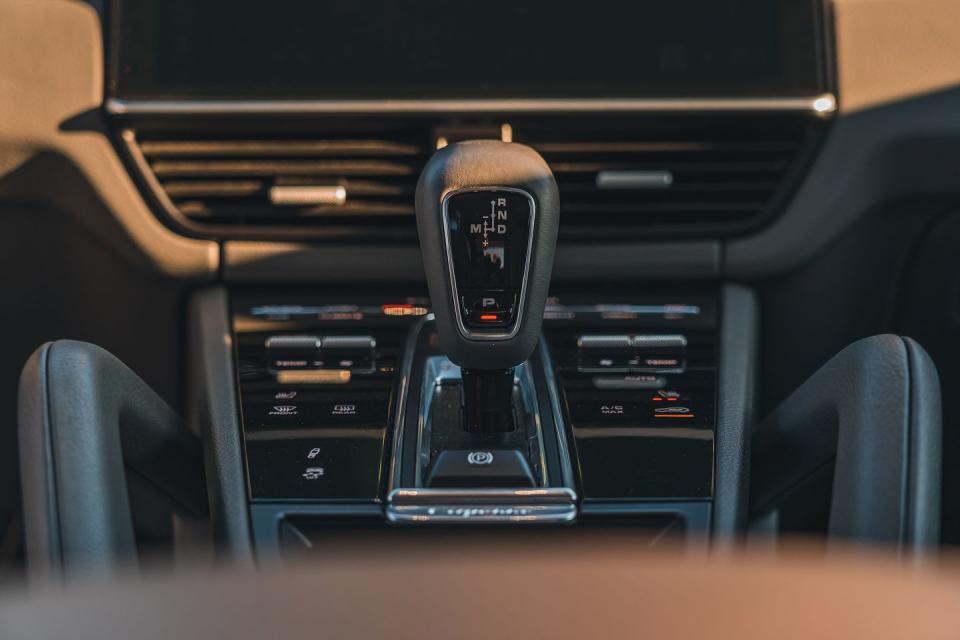
Once we realized we'd be working remotely a lot longer than expected, the Cayenne resumed its road-trip ways. It visited the Smoky Mountains, the Florida Panhandle, Nashville, Walt Disney World, and picturesque Alton, Virginia. Those highway trips revealed a long 540-mile range, which can be credited to the large 23.7-gallon tank and not the Cayenne's fuel economy. In our steady 75-mph test, the Cayenne managed 23 mpg, not much better than its 21-mpg average over 40,000 miles.
The most common complaint in the logbook centered on the eight-speed automatic's occasionally clunky shifts at low speeds. Slow for a red light and the stop-start system switches off the engine, but if the light goes green before you reach a full stop, the restart and initial forward acceleration have about as much grace as a neutral slam. Cold temperatures exaggerated the transmission's low-speed clunkiness. The dealership failed to re-create the problem—even after keeping the Cayenne for the night to ensure it was cold—so the issue continued throughout the test. Switching to Sport mode deactivates stop-start, which is what most of us did. Other Cayennes that came through the office didn't have this problem, so it'll remain an unsolved mystery specific to our long-termer.
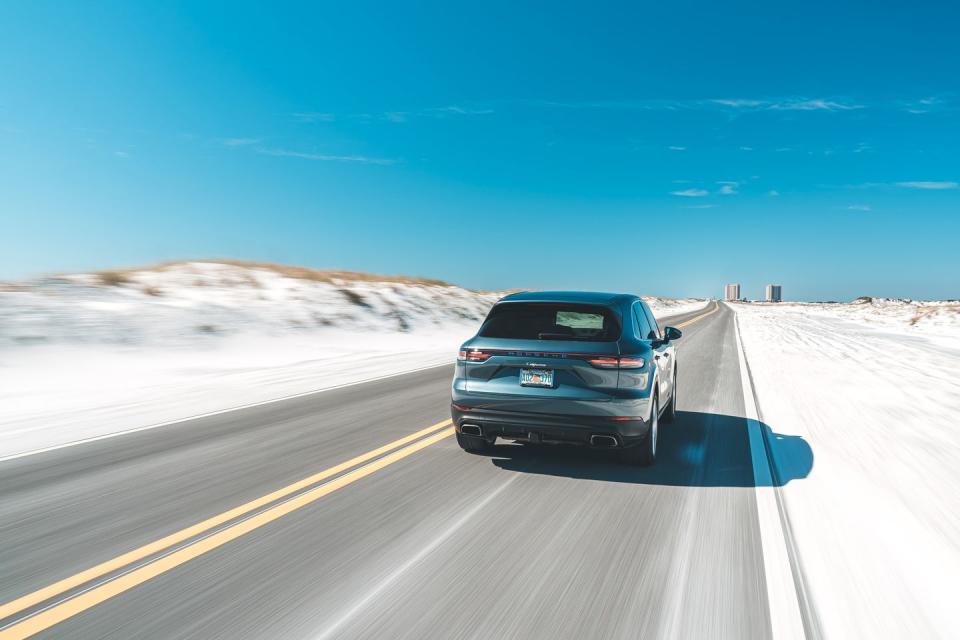
The best part of the Cayenne is that it's legitimately fun to drive and therefore makes commuting a bit more interesting. Crisp dynamics and taut body control make you forget that it is one of the many million non-cars contributing to the death of the sedan. After 40,000 miles of abuse, the Cayenne didn't lose so much as a single mph in the quarter-mile. What little difference we measured in braking and skidpad performance would be erased by a fresh set of Bridgestones. We still love sedans, but the Cayenne is so good at meeting a huge variety of needs that we get why it's popular. And, as far as the brakes are concerned: The 20-inch wheels were as bright as day one. Score one for the tungsten-carbide rotors.
Keep Cycling Cool
While perusing the Cayenne's Tequipment catalog, we happened across a heat-deflector kit for a bike rack. That sounds odd, but it makes sense. You don't want a bicycle's carbon-fiber bits damaged by hot and dirty exhaust. Upon investigation, we learned that the kit isn't available in the U.S., but the idea stuck. So we fitted a Thule Helium 2 ($800), a rack that places bikes out of the exhaust stream. The rack also protects carbon-fiber frames by grabbing the tires, features built-in locks (for both bike to rack and rack to car), and folds up when not in use or down when in use to improve hatch or trunk access. While it is pricey, the convenience of not having to remove a wheel or lift a bike up on the roof is worth it when you're sneaking in a lunch-hour ride.
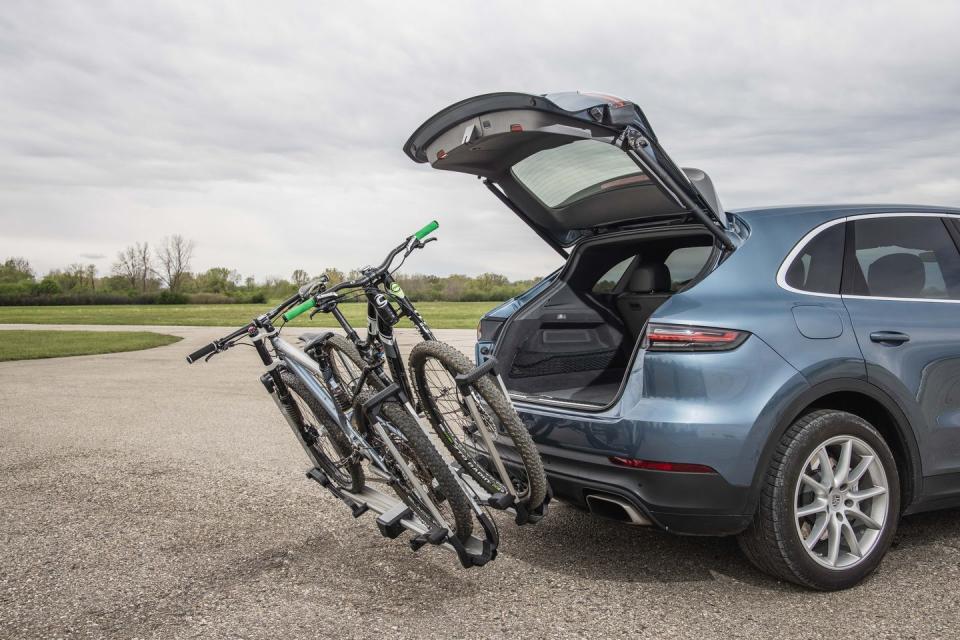
Rants and Raves
I figured the Cayenne used the ubiquitous ZF eight-speed automatic, but the way it fumbles shifts at low speeds and particularly while cold makes me think that can't be the case. —Dave VanderWerp
I can't believe VanderWerp doesn't know for certain it's a ZF 8HP. The Zeppelin Museum in Friedrichshafen is worth a stop. —K.C. Colwell
Feels surprisingly crisp, dynamically, on these Michelin Pilot Alpin 5 performance winter tires. —Dave VanderWerp
I don't like that the start/stop is buried in the infotainment, as it makes turning it off every time I get in that much more tedious. —Max Mortimer
I have programmed the diamond button on the steering wheel to deactivate stop/start. —K.C. Colwell
If every SUV drove like this, I'd be telling everyone to buy them. —Eric Stafford
Fun, fast SUV. —Juli Burke
The brakes squeal in wet conditions, which drew some sideways glances in parking lots. —Eric Stafford
Squeaky brakes in the rain. And jerky braking as it descends through the gears. —Juli Burke
Why the hell didn't we spec passive entry? First-world problems, I know, but still a pain. —Eric Stafford
There is someone in Stuttgart who saw our Cayenne build sheet and immediately went over to another cube with the paper and while pointing feverishly said, "See. I told you some idiot wouldn't get keyless entry." But in German. Maybe our spec caused keyless to become standard for 2020. —K.C. Colwell
Even with the dimming turned down all the way, the gauge cluster and center screen are way too bright at night. —Dave VanderWerp
At least Porsche doesn't have a dimmer setting of "0%" anymore. Zero percent of anything is nothing, but there was still light. And yeah, way too bright. —K.C. Colwell
30,000-Mile Update
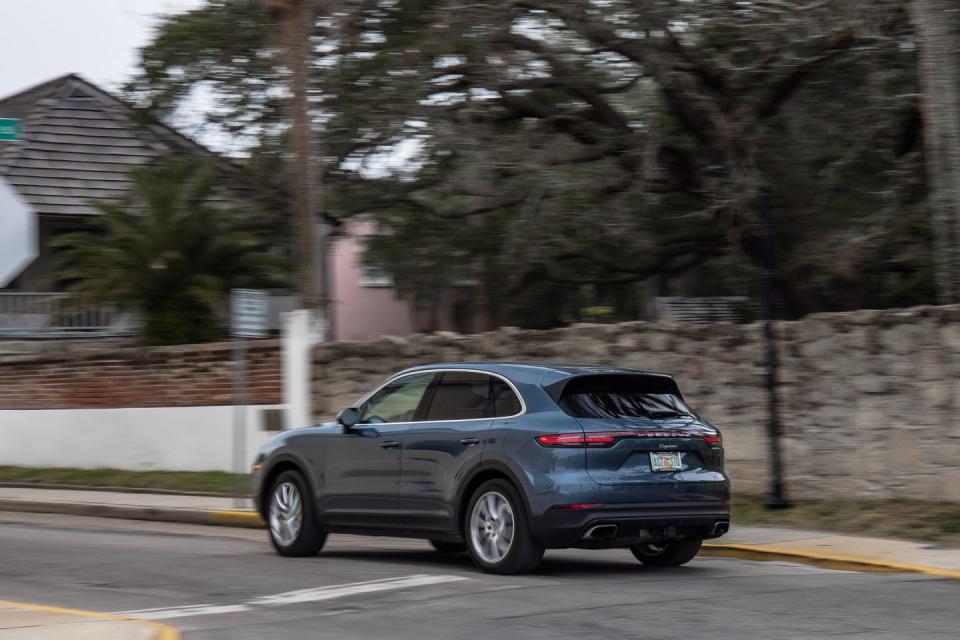
At our last checkup, our long-term Cayenne was the perfect patient. Only a certified quack in desperate need of cash could have found something fundamentally wrong with our Porsche SUV. Yet, while we have yet to encounter a serious problem with it, a few smaller concerns have crept up in recent months.
The most alarming issue is the unbecoming low-speed behavior of its automatic transmission. Although it hasn't been helped by Michigan's frigid winter weather, the clunky, jerky downshifts and stop-start driveline jolts that we've experienced recently are so uncharacteristic of its ZF 8HP eight-speed gearbox that one misinformed editor wrongly jabbed Porsche for not fitting the Cayenne with the ZF unit. This is somewhat understandable given that the 8HP's track record has been nothing but stellar in more than 15 of our long-term tests and countless other evaluations since its debut in 2008. Either way, the uncouth clunks that our Cayenne is exhibiting have gotten to the point that they warrant an unscheduled visit to the dealer for a diagnosis.

Just before its last scheduled service, the Cayenne's turbocharged V-6 let us know it was down 1.3 quarts of oil, which we filled after spending $21 on two quarts of Porsche-spec 0W-20. That 30,000-mile service wasn't a major one by Porsche standards, but it did include a new set of spark plugs in addition to an oil change and came with a hefty $1003 bill. An even larger cash drain came when we shelled out $200 to repair a mysteriously gouged wheel and another $2430 to replace another wheel when a driver lost control of the Cayenne while trying to avoid a pothole and struck a curb. That impact blew a hole in the right rear wheel, and that cost also includes getting the suspension back into alignment.
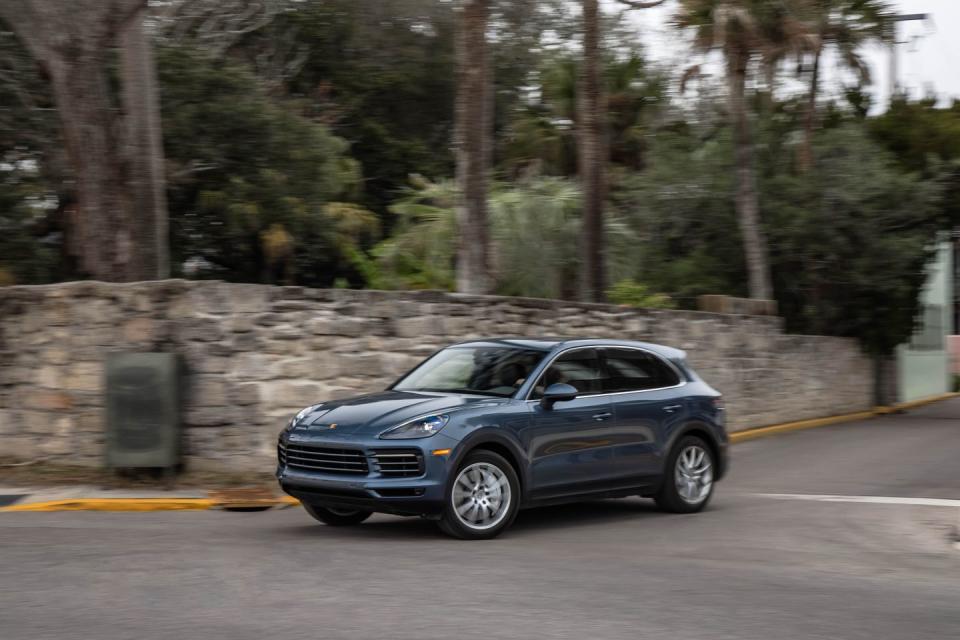
The 500 miles from its 30K-mile service to that unfortunate curb strike was far and away the most expensive stint in our Cayenne's life. That distance is usually reserved for the span between fill-ups on a road trip, which our long-termer has made plenty of lately, including jaunts to Florida and Virginia plus numerous escapes throughout Michigan. We remain smitten with its seemingly effortless driving dynamics considering its 4708-pound girth. We wish that all of its travel would have resulted in an uptick to its 21-mpg average fuel economy, but it hasn't. Our 75-mph highway fuel-economy test resulted in a 23-mpg score—on par with its EPA estimate but still not great.
At the time of this writing, the Cayenne has ventured south in search of a more photogenetic location for its final 40,000-mile sendoff, which is only a few thousand miles away. We're hoping that its costliest miles are behind us.
Months in Fleet: 14 months Current Mileage: 32,809 miles
Average Fuel Economy: 21 mpg
Fuel Tank Size: 23.7 gal Observed Fuel Range: 490 miles
Service: $1626 Normal Wear: $103 Repair: $299
Damage and Destruction: $3046
25,000-Mile Update
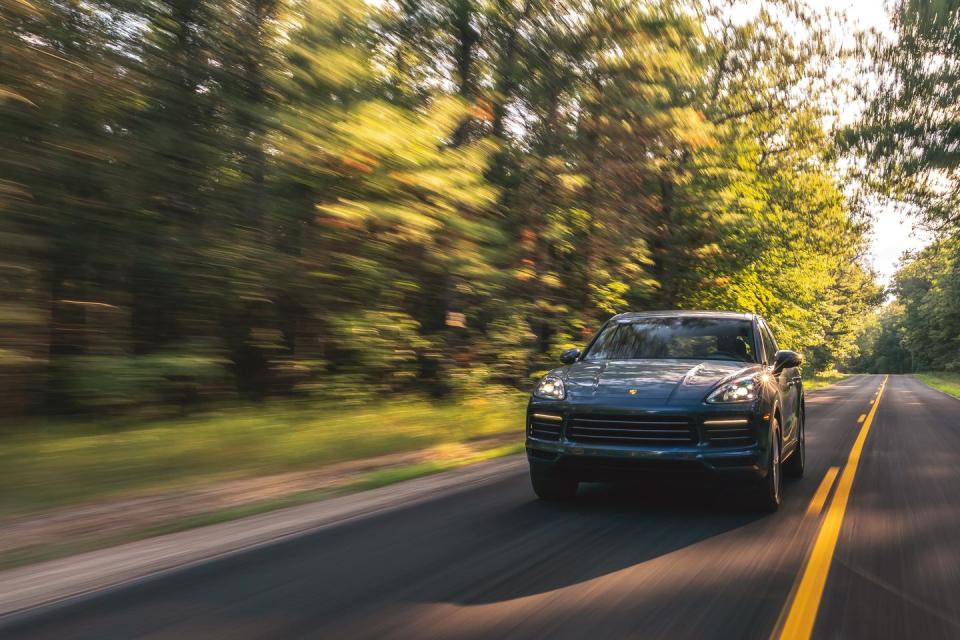
No news is good news when it comes to long-term cars. The perfect long-term car is one that delivers 40,000 happy miles, and our 2019 Cayenne is well on its way to achieving that platonic ideal. It's never left us stranded, and so far all of our gripes have been handled by the dealer. That is, when we remember to ask the dealer to examine something.
The Cayenne has been with us for about a year of trouble-free driving. Since our last update, the Cayenne had two dealer visits, both for scheduled maintenance. The first service was a partial redo because just as the odometer crested 10,000 miles, in March 2020, Michigan went into stay-at-home mode. To avoid potentially damaging the engine by using oil that was well past its lube-by date, we bought an oil filter and eight quarts of Porsche-spec 0W-20 (it's like pouring water) for $119 and performed the oil-change part of the 10,000-mile service ourselves. "It was money well spent," said the hypochondriac in our head.
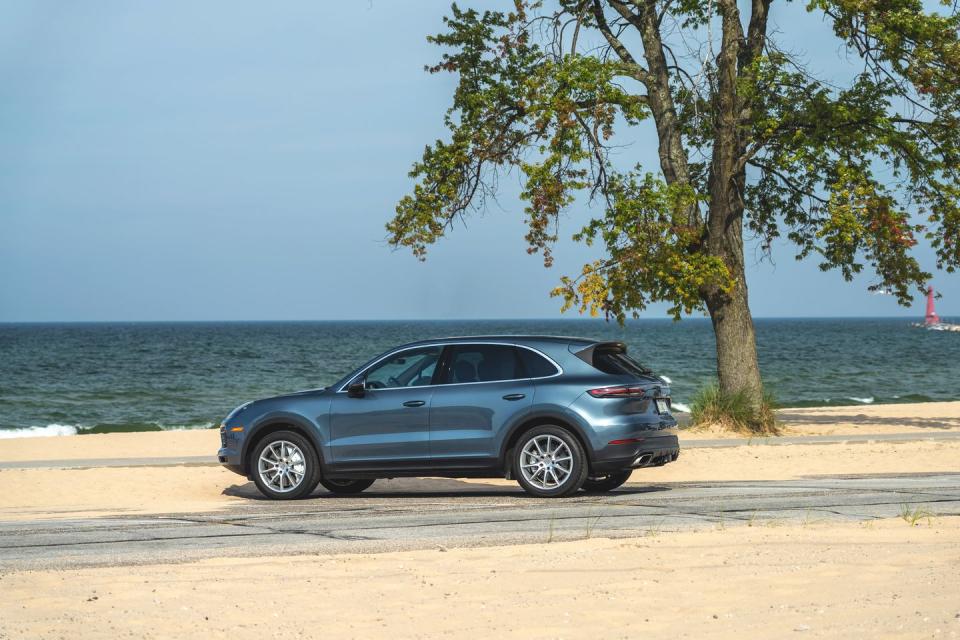
Just before the Cayenne hit 13,000 miles, we got it back to the dealer for the full 10,000-mile service. It's a freebie for the Cayenne that consists of a basic lube job and inspections. During that stay with the dealer, we learned of a pair of recalls to the optional Porsche Surface Coated Brakes (PSCB). These aren't the carbon-ceramic rotors Porsche puts on its hottest sports cars—those are PCCB—but the tungsten-carbide-coated rotors that are designed to reduce brake dust. (And they sport a cool mirror finish). The recalls (replacing the front brake pads and the springs for the rear pads) couldn't be performed at that time because parts needed to be ordered. When it went back a few weeks later, we also asked the dealer to look at the passenger-door alignment; we forgot to mention it at the service. At times the door wouldn't close with what we thought was an appropriate swing force. Our dealer didn't find the striker or hinges to be out of alignment, but they did lubricate all the moving parts, and that seemed to solve our sticky door.
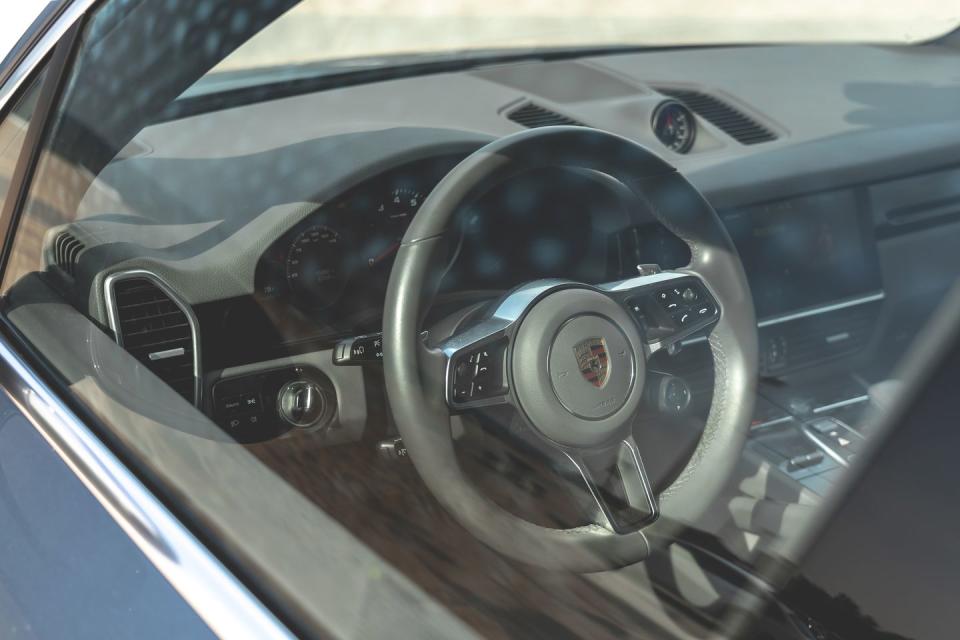
While that 10K service and recall work didn't come with an invoice, the 20,000-mile service reminded us that Porsche ownership is just as expensive as it sounds. It set us back $632. In addition to the work done at the 10K visit, the 20K visit calls for replacement of both the cabin and the engine air filters. The dealer also replaced some worn-out wipers for $82.
While we love the Cayenne's handling, some of the day-to-day dynamics could be improved upon. An aggressive stop-start system often kills the engine too early, and the restart occasionally comes with a horrible driveline thud. Disabling stop-start eliminates the thud, but we can't help but wonder if the occasional transmission stumble on cold mornings is related and a sign of something else going on with the ZF automatic. We will for sure be bringing this up with the dealer in about 5000 miles. Also, the brake pedal requires quite a bit of acclimation. The initial firmness is great when setting up for an apex, but it turns to undesired grabbiness at more relaxed speeds. It just takes a day to get used to, so it isn't a total dealbreaker.
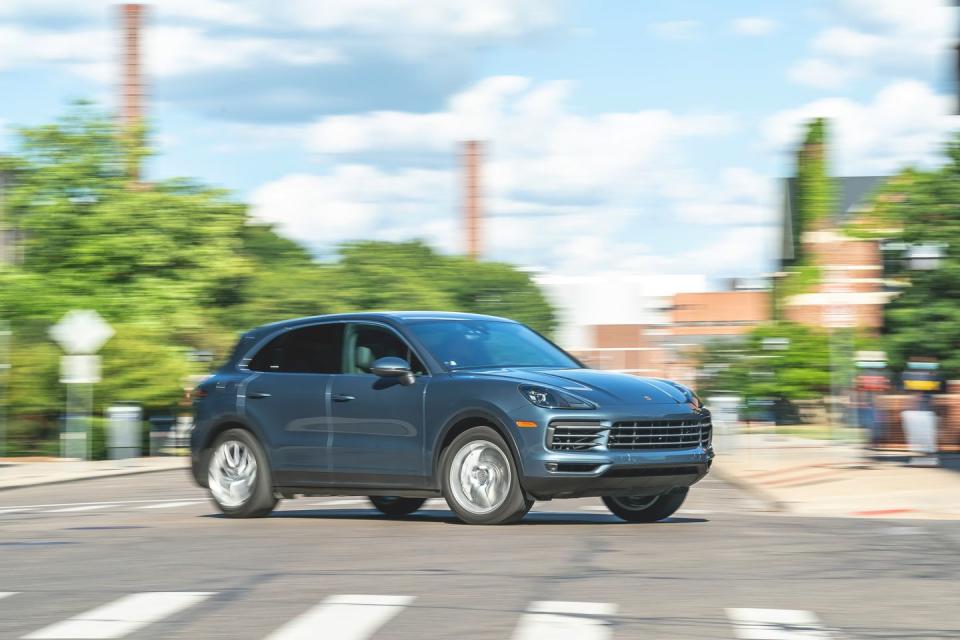
We've averaged just 21 mpg so far, and we don't expect that number to budge much. While we are now taking the Porsche on more trips—it's trekked to northern and western Michigan, as well as southern Virginia—the high-speed fuel economy isn't great. We averaged 23 mpg on our 75-mph highway fuel-economy test, and that's about the best we've seen out of a full tank. Then again, this is a Porsche, and it's glad to cruise at 90 mph. Here's to 15,000 more happy miles.
Months in Fleet: 11 months Current Mileage: 25,848 miles
Average Fuel Economy: 21 mpg
Fuel Tank Size: 23.7 gal Observed Fuel Range: 490 miles
Service: $632 Normal Wear: $82 Repair: $0
Damage and Destruction: $416
10,000-Mile Update
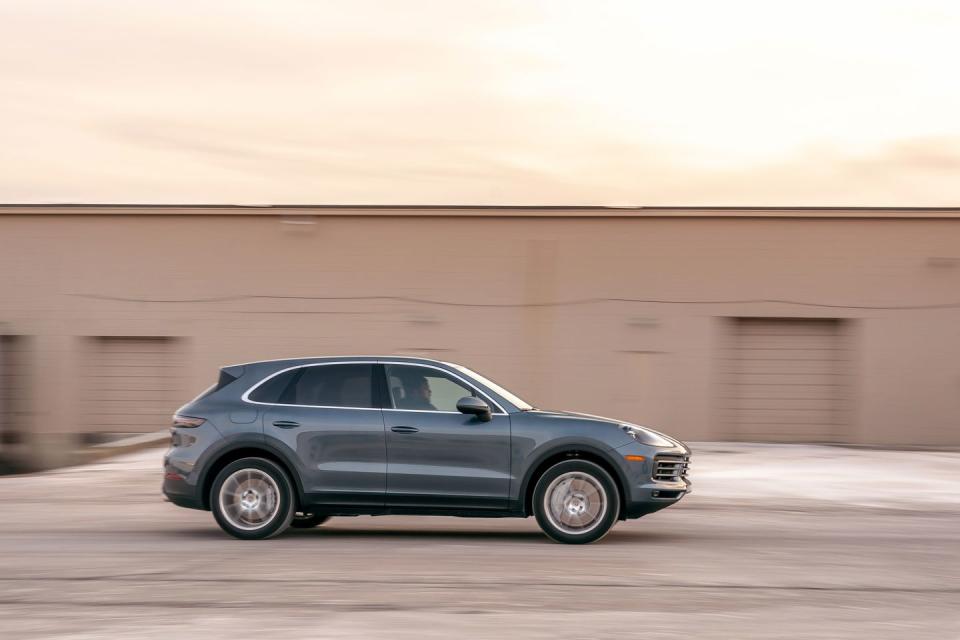
Most of the C/D crew has been holed up at home for about a month. Because of that, this long-term Cayenne, as well as the rest of our fleet, has not been gathering miles at the usual pace. During this (so far) roughly monthlong containment, our Cayenne accumulated fewer than 1000 miles. (Someone at Porsche reading this just did the mental math, and no, it will not take 30 months more to complete this test.) But we have driven it just enough to break the 10,000-mile seal, triggering an update.
Three months into the loan, we were on pace for a 12-month, 40,000-mile test. While that pace has slowed, our professional nit-picking hasn't. Don't get us wrong, this is one fantastic SUV. The first half-dozen comments in the logbook all praise the Cayenne's dynamics—not a huge surprise since the Cayenne is a comparison-test winner.
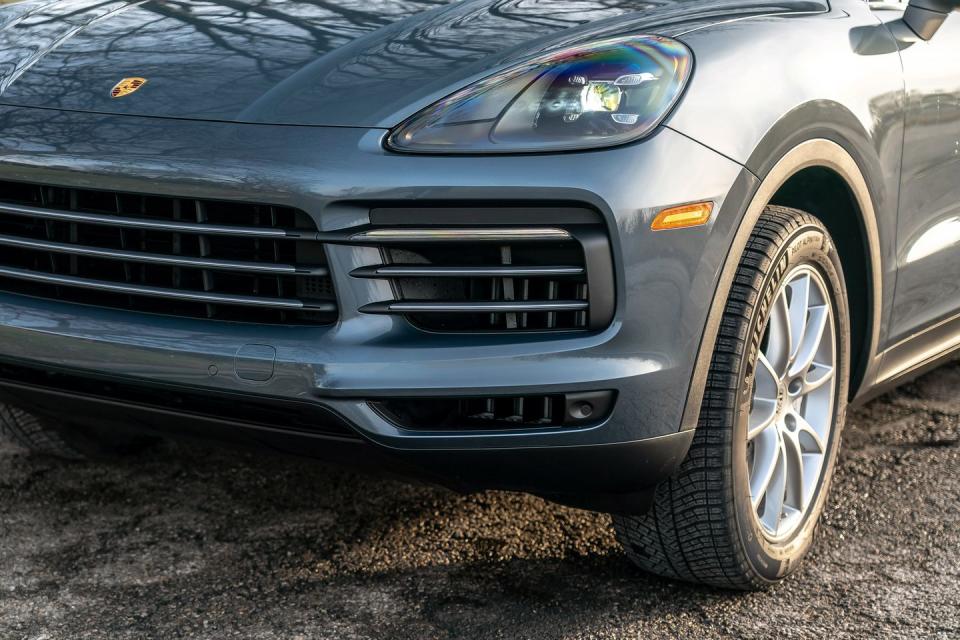
All Porsches are pricey, but a base Cayenne like ours is priced right against its peers. Sure, competitors do come with a longer list of standard features, things that you take for granted such as passive entry. When we ordered our Cayenne, we thought the $940 stand-alone option price was a bit excessive. Our opinion on the cost has not changed, and while we have only just gotten used to pulling the key out to unlock the car, then returning said key to our pocket before starting the car—you don't need to insert the key to start the car—we do find it a bit annoying to have one but not the other, considering our Cayenne is $80K. Staff editor Eric Stafford captured it perfectly in the logbook: "This first-world problem is a first-world pain in the ass."
Driving at night on back roads has brought to light (sorry) the inability to dim the instrument cluster sufficiently. On a dark road, the interior lights glare into our eyes. Not only that, dimming the lights requires you to go through a menu in the infotainment system, and there are three separate dimmer controls for the instrument cluster, clock on the dash, and center touchscreen. Remember dimmer knobs? Porsche says forget them; doing it through an infotainment menu that can't be adjusted while moving is a much better solution. This is a prime example of technology taking a simple task and making it unnecessarily complicated. Granted, most owners will set it once and be done with it. Either way, "-5" for all three settings isn't dim enough for our liking.
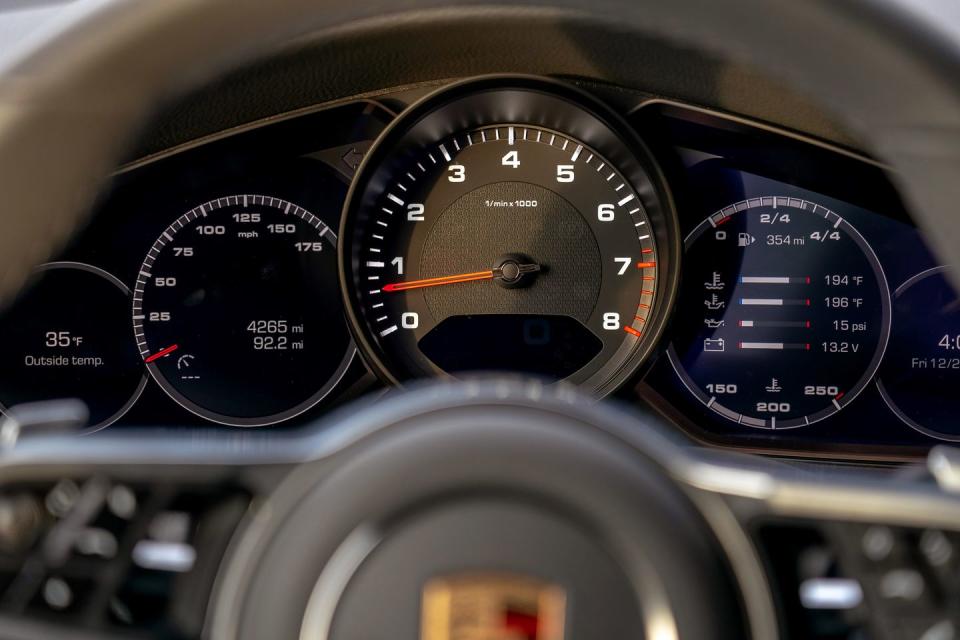
We haven't had to take the Cayenne in for service yet. It is due for its 10,000-mile check-up (oil change and a host of inspections), but considering we'd have to let a stranger or two sit in the driver's seat, our commitment to social distancing dictates we wait until the shelter-at-home order has been lifted. If the miles start piling up—unlikely—we will order Porsche-spec oil and a factory filter and do it in the driveway. When we do get to a dealer, we'd like them to take a look at the passenger door's annoying habit of not sealing when you close it. We're guessing the striker alignment is off slightly. It's the little things, right? These days, however, they seem extra small, and we are grateful that in a world where all vehicles are relegated to grocery getters, the Cayenne remains a fun and refined one.
Months in Fleet: 5 months Current Mileage: 10,474 miles
Average Fuel Economy: 20 mpg
Fuel Tank Size: 23.7 gal Observed Fuel Range: 470 miles
Service: $0 Normal Wear: $0 Repair: $0
Damage and Destruction: $0
Introduction
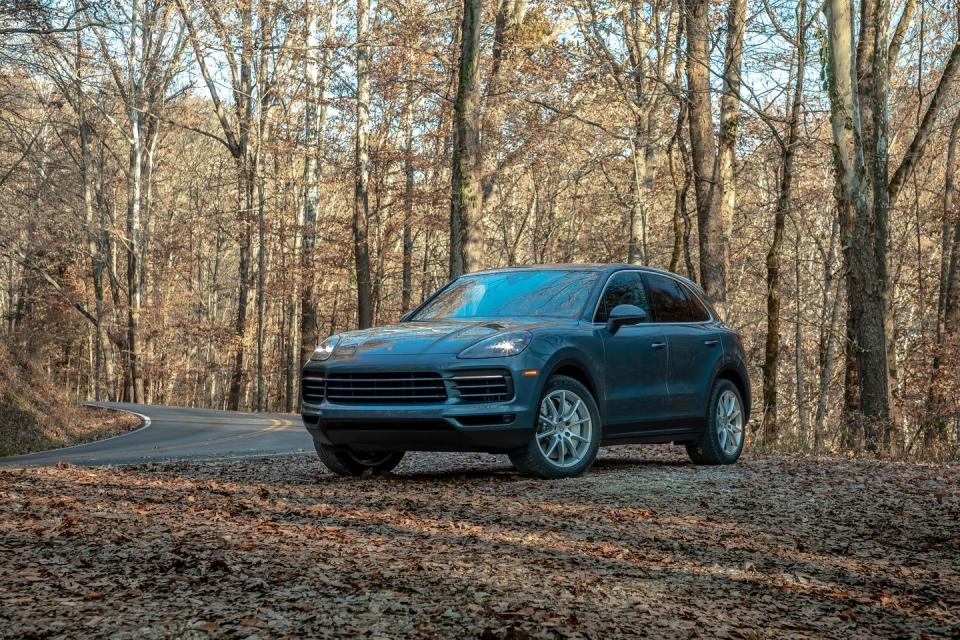
When we got the go-ahead for a long-term 40,000-mile Porsche Cayenne, we pretty much knew what we wanted. Well, we knew at least whatever configuration we decided on would spark more than a few arguments among our staff. Because one of our favorite things to do is tinker with Porsche's online car configurator, everyone here at C/D HQ had some idea what they wanted, individually. Coming to a consensus took some work.
When the dust settled, though, we ended up with a conservatively optioned Porsche SUV that felt like a suitable compromise. Technical editor and snowmobile-trailer-towing enthusiast David Beard was pleased with the $660 trailer hitch but irked that it does not come with a trailer wiring connector from the factory. The dealer charged us an additional $72 for a seven-pin connector that we installed ourselves. Beard also was put off that we didn't get the $2000 off-road package for its skid plates, dash-mounted compass, and additional tow hook. (Beard's typical weekend plans often include getting stuck in snow or mud.) What he didn't realize is that the off-road package forces an additional $4490 in other upgrades, notably air springs, that we didn't think were worth the upcharge. Our art department was happy that we spec'd the car in a sharp color, $800 Biscay Blue metallic. And everyone agreed that we needed Porsche's superbly tuned adaptive dampers ($2000), the 14-way power-adjustable seats ($1900), and heated front seats ($530) to maximize the Cayenne's comfort quotient.
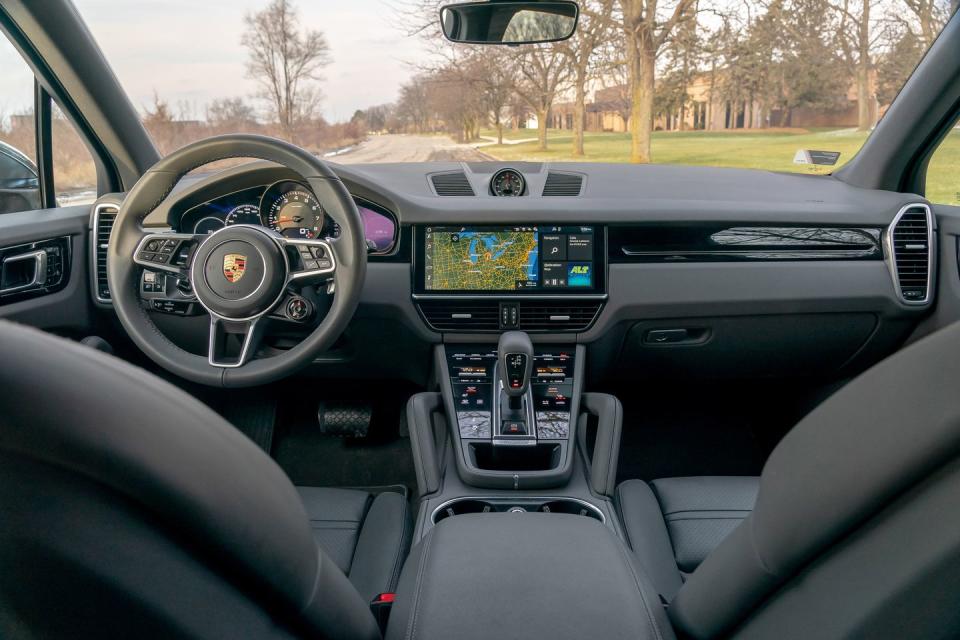
We also agreed that we should get the new Porsche Surface Coated Brakes (PSCB.) Because science. Porsche claims these tungsten-carbide-coated rotors improve performance, and they better, what with 10-piston calipers squeezing 16.3-inch front rotors and 14.4-inch rotors with four-piston calipers in the rear. But, more important, they also reduce brake dust on the wheels. What we didn't immediately realize is that those massive front discs won't fit within the Cayenne's stock 19-inch wheels. That meant the $3490 brake-hardware experiment grew by another $1720 for 20-inch Cayenne Design rollers. Porsche also may have snuck in the Sport Chrono Package ($1130) on us, but we're not mad. Without it, we wouldn't have launch control.
Special Delivery
All told, our entry-level 2019 Cayenne, which started at $66,950, rang in at $79,530. This is about the normal delta between base and as-tested prices that Porsche expects to see with its Cayenne models, only there won't be too many Cayennes with PSCB out there. And if you've been following along with a calculator, as some of you do because we get the letters, you'll notice that there is $350 left off the tally. That's because we took part in the Porsche Experience Center Delivery, er, experience at PCNA's headquarters in Atlanta.
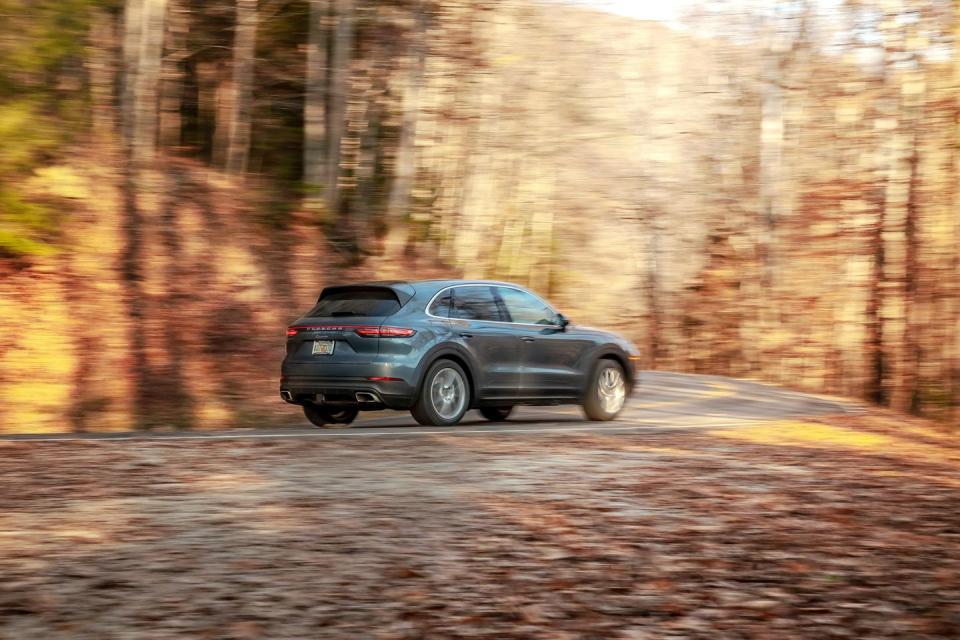
For $350 (the price recently jumped to $395) you can fly to Atlanta (or Los Angeles, but that location is a little more expensive), get a behind-the-scenes tour of the Porsche center, receive 90 minutes of track instruction in a similar car, and eat lunch before a one-on-one walk-through of your vehicle with a product specialist. Our track-vehicle proxy was a Cayenne Turbo, and because Porsche SUVs ostensibly have some off-road capability, that 90-minute window also included some off-road instruction on a purpose-built obstacle course.
Porsche's delivery process is an indulgence. For most people, it requires a flight and at least one night in a hotel, making it a luxury on top of an already luxurious purchase. But if you've been pining for a Porsche and ordered a car after spending weeks on the online configurator, it is a worthwhile reward.
Before we left Atlanta, we installed a set of OE-size Michelin Pilot Alpin 5 SUV winter tires, which are pretty quiet as far as winter tires go. Those set us back a not-insubstantial $1506 before installation, and some of that cost surely lies with these being N0-spec winters, meaning they are developed specifically for a Porsche.
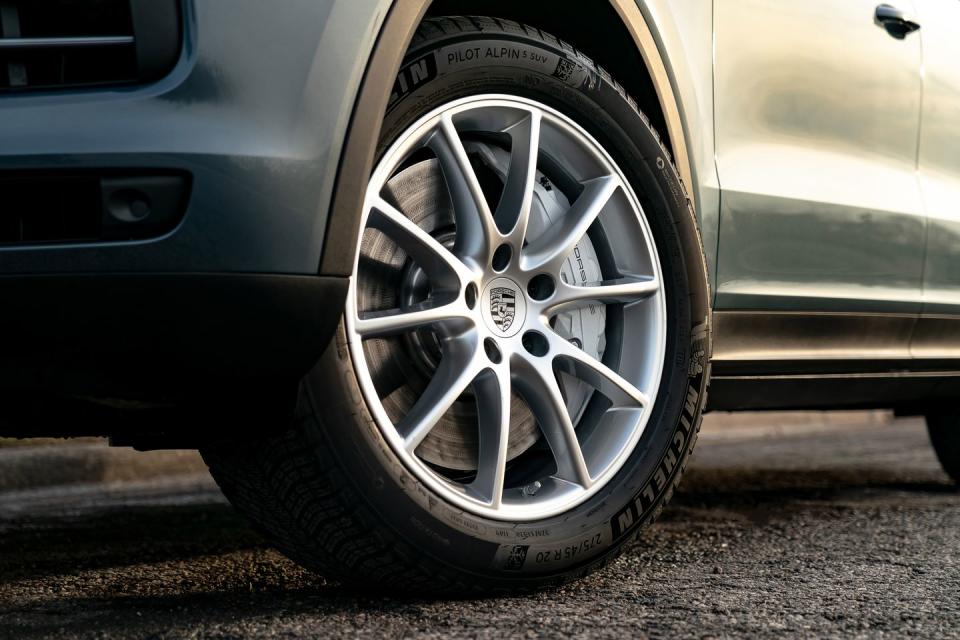
On its stock Bridgestone Dueler H/P Sport summer tires, our 4708-pound Cayenne stops from 70 mph in 158 feet and holds onto the skidpad at 0.95 g. While those aren't mind-blowing numbers, remember, this is just the base Cayenne model. With a modest 335 horsepower from its turbocharged 3.0-liter V-6, the Cayenne scoots to 60 in just 4.9 seconds and trips the quarter-mile lights in 13.5 seconds at 102 mph.
All of these performance numbers are in line with the other starter Cayenne that we previously tested, which also happened to be a comparison-test winning Cayenne. So, we have a good idea of what to expect. Despite our personal preferences, our long-termer surely will help make many of our upcoming fair-weather vacations more enjoyable ventures. Until then, however, it will continue to battle Michigan's dreary, sloppy winter, probably with a snowmobile or two in tow.
Months in Fleet: 2 months Current Mileage: 6613 miles
Average Fuel Economy: 19 mpg
Fuel Tank Size: 23.7 gal Observed Fuel Range: 450 miles
Service: $0 Normal Wear: $0 Repair: $0
Damage and Destruction: $0
You Might Also Like

 Yahoo Autos
Yahoo Autos 